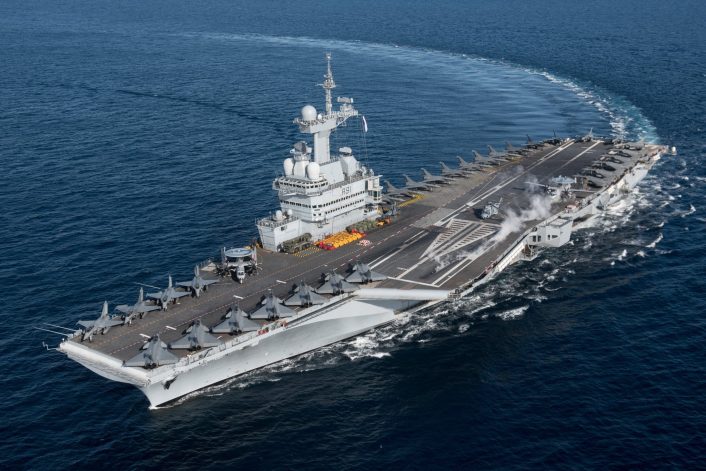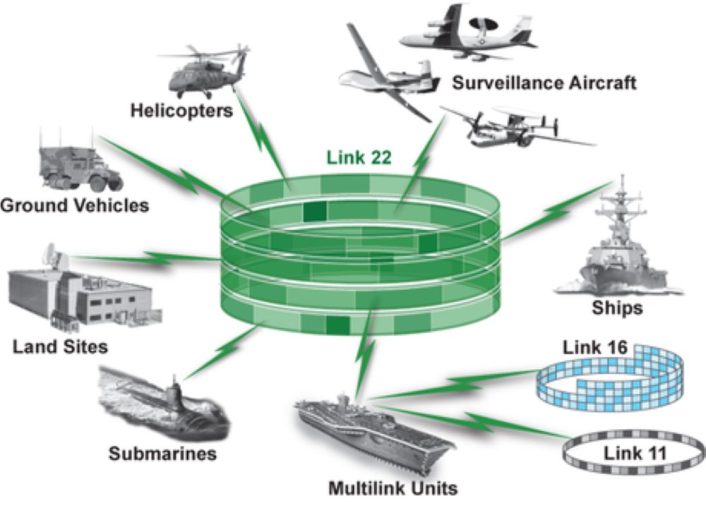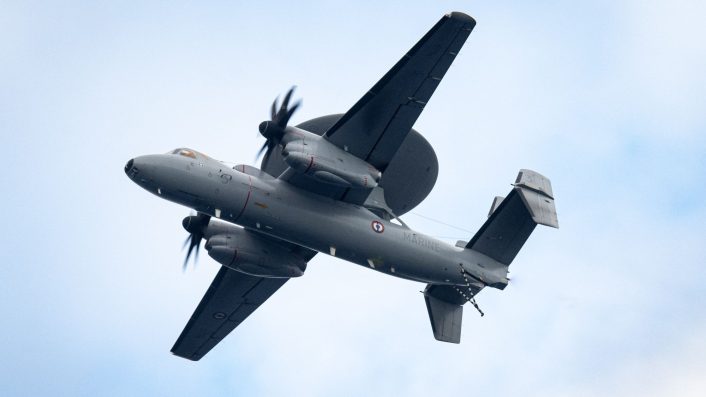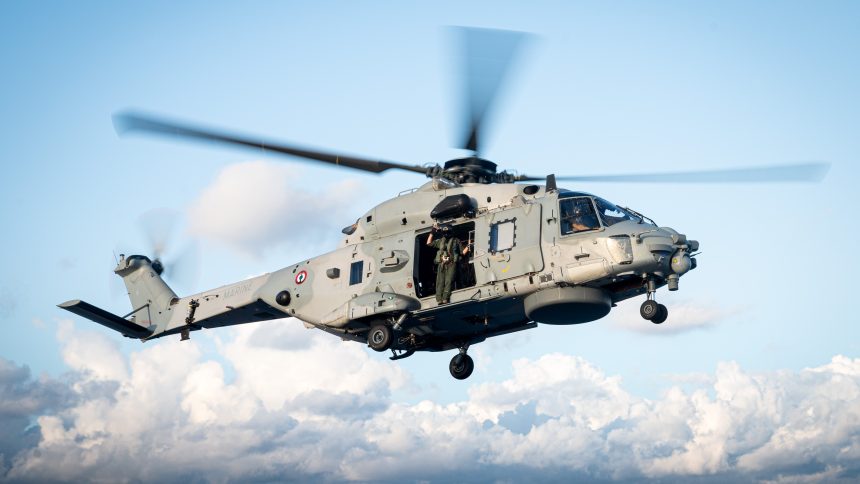The Marine Nationale says it needs to adapt to an atmosphere that demands ‘shorter reaction times,’ and the new Link 22, together with the Link 16, allows all tactical data concerning an area of operations to be shared in real time.
The French Navy (Marine Nationale) announced on Feb. 26, 2025 that it has tested the Link 22 tactical data link system with the FNS Charles De Gaulle CSG (Carrier Strike Group) with the goal of replacing the Link 11. The CSG is currently in the Indo-Pacific for the Clemenceau 25 deployment, which departed from Toulon on Nov. 28, 2024.
The testing has been ongoing since the vessels left the port, with the first operational flights of the Caïman Marine (the French designation for the NH90 NFH) conducted during the first weeks at sea. The helicopters operated from both the aircraft carrier and the frigates escorting it.
Further testing was performed in January 2025, during the multinational Exercise La Perouse 25 off the coast of Indonesia, and February, during the trilateral exercise Pacific Steller between the French, U.S. and Japanese navies, where the CSG put the Link 22 tactical data link (LDT) through the paces to test all its capabilities.

During Pacific Steller, the Link 22 allowed the French CSG to share data with the U.S. and Japanese navies in a quick and secure way. Thanks to its capabilities, the CSG “was able to validate situations shared via the L22 by Japanese and American ships,” said the French Navy.
“Since its departure from Toulon, the naval air group (GAN) has been experimenting with the L22 tactical data link on its aircraft to share tactical data from an area of operations in real time,” the CSG said on X.
For Clemenceau 25, the FNS Charles De Gaulle CSG had sailed from its home base at Toulon in France on Nov. 28, 2024, where it deployed to the Mediterranean, Red Sea and Indian Ocean for nearly a month, before heading to southeast Asia (for La Perouse) and then the western Pacific (Pacific Steller).
#CLEMENCEAU25 | Le GAN teste la liaison L22 🛩️
Depuis son appareillage de Toulon, le groupe aéronaval (GAN) expérimente la liaison de données tactiques L22 sur ses aéronefs pour partager en temps réel les données tactiques d’une zone d’opérations. @French_CSG #innovation pic.twitter.com/M1HKZZH8hZ
— Marine nationale (@MarineNationale) February 26, 2025
Link 16 and Link 22
As it now emerges from the Marine Nationale release, a part of the mission was to test and validate the Link 22. This was sanctioned by the Directorate General of Armaments (DGA), supported by the Naval Programs Expertise Center, the French Navy’s LDT Operational Center, the escorts’ combat system experts, the LDT cell of the embarked staff, as well as the teams from the Naval Aeronautics Practical Experimentation and Reception Center (CEPA/10S) in Toulon.
The Marine Nationale stated that the rationale behind testing the Link 22 was to adapt to an environment that demands “increasingly shorter reaction times,” where the new “LDT 22, together with the L16, allows all tactical data concerning an area of operations to be shared in real time.”
Link 22 was developed to replace and overcome the known deficiencies of Link 11, and to complement and interoperate easily with Link 16. The development program to replace the Link 11 was called the NILE (NATO Improved Link Eleven), and the tactical data link provided by the NILE system was then officially designated Link 22. Seven NATO member nations are a part of the Link 22 project, including the US, UK, France, Canada, Germany, Italy, and Spain.

The Link 16 has its limitations in terms of the vulnerability and integrity of its communications in today’s battlespace. The Link 16 also transmits the data in an omnidirectional fashion, spreading everywhere, with the transmission highly vulnerable to being intercepted. On the other hand, the Link 22 boasts greater anti-jamming capabilities and improves “command efficiency while providing faster communications transmissions.”
Link 22 features an automatic grouping function that can fully map out the positions of enemy and friendly forces via a common operational picture (COP). In the Indo-Pacific theater, the Link 22 would have to compete with China’s XS-3 and DTS-03 data links, which some sources claim as superior to Link 16.
The Link 22’s website describes it saying it allows beyond the line of sight (BLOS) communications with “gapless communication range extended up to 1000 NM.” Other features listee are “increased robustness for standardized data rates,” and “increased throughput by additional high-speed waveforms.”
The most advanced data link system in the U.S. inventory is however believed to be the F-35’s MADL (Multifunction Advanced Data Link), which rapidly transmits packets of data back and forth, making it difficult to intercept. It is not known if ongoing TR3 (Technology Refresh 3) and Block 4 upgrades of the F-35 will also involve the MADL, but it is unlikely the system would be ignored among the targeting, weapons and sensor fusion capabilities that are covered by the program.

French Link 22 testing
An important revelation in the release was that the L22’s capabilities are being tested throughout the entire deployment of the CSG, including both La Perouse 25 and Pacific Steller exercises. It is not clear if the Link 22 has been already installed across all French aerial and naval platforms or what is the timeline for the replacement of the Link 11, once the newer version is validated.
The fact tha Japan has now presumably received the Link 22, despite not being a member of the development program, bears the technology’s necessity in a electromagnetically challenging high-end scenario in the western Pacific before China.
#PartnersAndFriends for the sake of peace and stability. Here as well as anywhere else, 🇫🇷 Rafale Marine operating from #USSVINSON during #PS2025. pic.twitter.com/C91RDr1ig2
— The 🇫🇷 Joint Staff – Military operations (@FrenchForces) February 16, 2025
Images released by the French Navy with the news showed a Marine Nationale NH90 Caïman helicopter and an E-2C Hawkeye AEW&C (Airborne Early Warning and Control) aircraft. While the involvement of the Caïman naval helicopters was mentioned in the press release, no mention was made about the system being installed on the Hawkeye.
The drills with the U.S. and Japanese navies was also the participation of the Dassault Rafale Marine, the primary strike, air superiority and multirole platform of the French Navy. During the exercise, the Rafales and F/A-18E/F Super Hornets conducted cross-deck landings on the USS Carl Vinson and the FNS Charles De Gaulle, with the Rafale also refueling Super Hornets.

Urgent tactical need among Allies
Lieutenant Commander Jérémie, head of the LDT cell of the French air-maritime rapid reaction force, said in the release: “Highly secure and based on constantly evolving technology, significantly increase the capabilities of knowledge and control of a tactical situation, as well as decision-making facilitated by a shared vision between the different levels of command.”
Back to #PacificSteller ➡️During this activity, the CSG1 provided a part to the #FrenchCSG to regain full availability of one of its E2C Hawkeye aircraft. 🇺🇸🇫🇷#Interoperability even in maintenance !
More details ⬇️https://t.co/YBWHoANww2 pic.twitter.com/2V4efEgEkQ
— French Carrier Strike Group (@French_CSG) March 2, 2025
Because of this, Link 22 allows the CSG to maintain a high level of interoperability with its allies having this tactical data link, such as the United States, Italy and Canada. The CSG “thus ensures its control of vast air-sea spaces and contributes to the maintenance of an autonomous situation assessment capacity,” needed “in an increasingly complex geopolitical context.”
As of Feb. 16, 2025, the French CSG was still executing components of the Pacific Steller 2025 MLDE (Multi-Large Deck Event) exercise. The latest was acquiring parts for the Marine Nationale’s E-2C Hawkeye 2000 from the USS Carl Vinson, that carries the E-2D Hawkeye under the VAW 113 (Airborne Command and Control Squadron) “Black Eagles”, since the two variants share many interchangeable parts.
“This MLDE is designed to advance coordination and cooperation between French, Japanese and U.S. navies while simultaneously demonstrating capabilities in multi-domain operations, promoting a shared dedication to regional stability and highlighting the U.S. Navy’s enduring power projection capability,” said the U.S. Navy. The transfer of the Hawkeye’s components allowed to “showcase the integrated logistical chain used to keep aircraft operational while participating in Exercise Pacific Steller 2025.”









